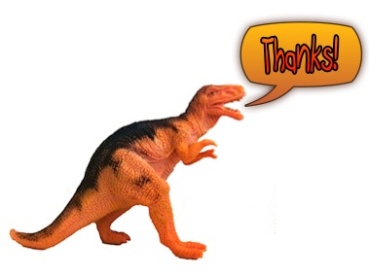There is a certain art to figuring out the right incentive to drive participation for any kind of evaluation activity. Do you offer something small to everyone who participates, or a chance to win one or a small number of more valuable incentives? Offer too much and you might blow your budget; offer too little and you may not get enough participants. Further complicating matters is the fact that no pool of potential focus group participants or survey respondents is identical – what might work well for a group of high-school students in California may not cut the mustard with a group of informal science educators in St. Louis. Not surprisingly, the true value of any incentive is in the eye of the beholder – and with that in mind I wanted to share a story about a very successful survey campaign that incentivized adult respondents with merely a chance to win a toy dinosaur.
As part of our evaluation effort for Radiolab <http://www.radiolab.org/> (the popular science podcast and radio show produced by WNYC), we created a survey to gather feedback from people who attended their live show, Radiolab Live: Apocalyptical, in venues throughout the United States. For lack of better and more scientific terms, the audience for Radiolab and its live show tend to be young, hip, and very creative — they have done everything from writing songs, making videos, and creating new logos, to helping name our mammalian ancestor. So, instead of offering a chance to win an iPod loaded with Radiolab podcasts — which, as a high-value prize, presented certain legal hurdles — we ultimately decided to scrap the idea of a prize with high monetary value, and return to the drawing board with the added challenge of finding an original incentive that had no real monetary value, but would still be seen as valuable by potential respondents.
It was Molly Webster, a member of Radiolab’s production team who stumbled upon the genius idea to offer a toy dinosaur, signed by Jad Abumrad and Robert Krulwich, the show’s two hosts, as the incentive. In her own words:
I have one sitting on the shelf to the right of my desk, staring at some fossils I collected in the field while reporting the story, so when I dropped my head to the side in a sign of frustrated desperation, trying to think of what we could give away, my eyes settled on it. And ahoy! It became our prize.
What made the dino such a great incentive? First off, dinosaurs played prominently in the Apocalyptical program, so it was a prize that was likely to resonate with individuals who’d seen the show. Secondly, the dinosaur had a very minimal cash value, meeting the low-value preference. Thirdly, since it was small and unbreakable, it would be easy to ship to a winner anywhere in the US. But finally – and most importantly – I suspect it was the show hosts’ signatures that elevated it from a cool, albeit quirky, prize to something that Radiolab fans really wanted to win.
As an evaluator, I’m usually thrilled when I get a couple hundred survey responses for a program of this nature – so I was truly amazed when we got more than 6000 survey responses! Did the dino make a difference? Obviously we can’t know if the dino was a more popular incentive choice than an iPod would have been, but based on past experiences where we’ve offered a more conventional incentive and gotten far fewer responses, I feel that the creativity and uniqueness of the incentive might have been an advantage in this instance. It also didn’t hurt that Radiolab listeners, i.e. the folks who made up the majority of the Apocalyptical audience, are really passionate about the show and likely valued the opportunity to provide feedback to help make something they love even better. None-the-less, 81% of respondents opted in for a chance to win the dino – and one lucky winner received a plastic dinosaur signed by Jad and Robert in her mailbox.
My take-aways from this experience: 1) Don’t be afraid to think outside the box where incentives are concerned. 2) Keep your audience in mind and try to come up with incentives that they will perceive to be valuable – even if there’s little or no monetary value. 3) Involve clients in the incentive-brainstorming process – they know their programs and audiences better than anyone and might have a brilliant incentive idea that could drive thousands of responses for your next survey.
